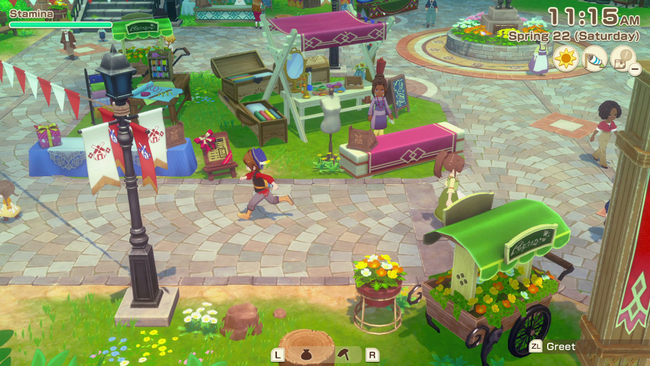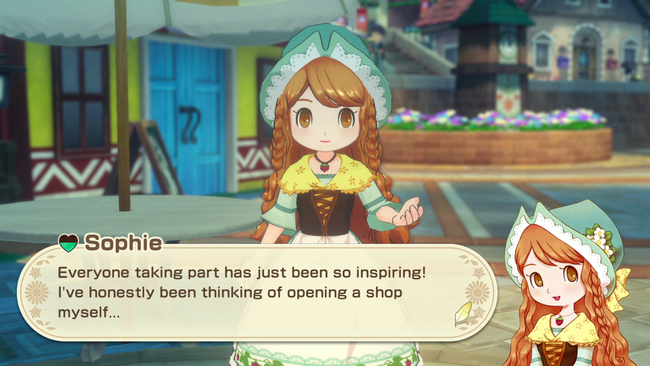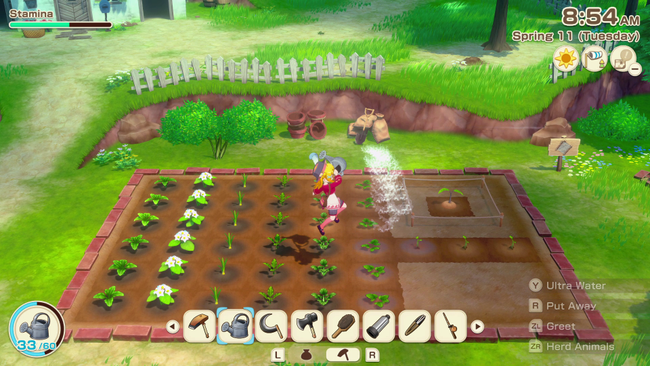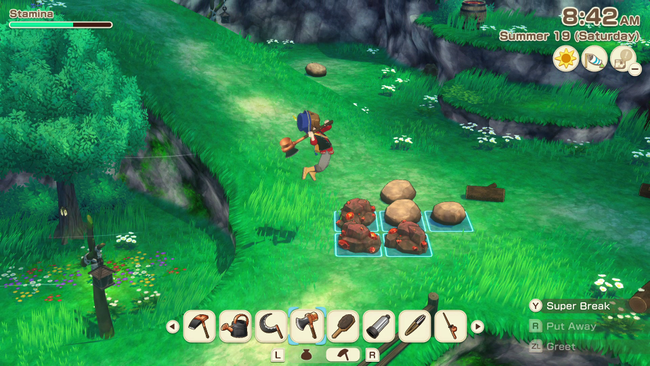
Story of Seasons: Grand Bazaar Review
Remakes can be an excellent excuse for a development team to revisit unfinished and unrefined ideas, and to give them a second chance - and Story of Seasons: Grand Bazaar feels like a near perfect example of just that. An entry in the series that, while it had its fans, felt like it was missing a few pieces to bring everything together when the original version launched on the Nintendo DS. Clearly, Marvelous thought with a little extra care they could make something special, with ties to both the series' heyday and its more modern approach.
It's a bit difficult to keep track of everything that's new and has changed, so more importantly I'll describe how it feels to play Grand Bazaar in its new incarnation, while noting changes when they're immediately obvious. The first of which is an increase in general scope; Zephyr Town and the surrounding areas are larger, including a new Mountain Trail dotted with any number of resources for players to engage with, including eventually mushroom logs and beehives that players can purchase to make use of once new character - and Bachelor - Arata joins the Bazaar.

For those not familiar, the main gameplay hook of Grand Bazaar is a weekly Bazaar, where members of the town set up shop to sell their goods and services every Saturday. Compared to the rest of the series, this gives the title a special sort of structure to plan towards; it's no longer just enough that you grow your crops to sell them right away, but you must plan what you'll have ready for the weekly Bazaar, and when. Every action you take in the game must consider this; while you can sell items in a pinch, you lose out on both progression and a not insignificant amount of money by forgoing the activity. Since the scope of Zephyr Town has increased, players can now make use of a glider to ride the towns signature wind to locations new and old.
Another new aspect that ties into the Bazaar are the Harvest Sprites; despite being a regular occurrence in the franchise, the original Grand Bazaar lacked their inclusion. In this remake, they can help you sell out your stock during the Bazaar, and offer their own shop wherein you can spend Happy Points you've earned by completing actions that signify a life well lived. Their stall - which is only accessible on Bazaar days - offer stamina upgrades, access to your home's storage from additional locations around the town, new customization options for your Bazaar Stall, and more.
Outside of the Bazaar, these sprites offer a different service - each of the 5 little gremlins have an association with a different class of item. Forageables, Fish, Bugs, Mushrooms and Honey; if you gift a Sprite their respective class of item, you can level them up. While most times this will just offer a bunch of Happy Points, every 4 levels will also grant an inherent quality increase to items gathered of that type. That includes gems, which are now far more plentiful now due to consistent mining points added with the new sections of the map. We'll get back to that, later.

One result of this feature is to expand upon elements of the game that may have felt under baked before, but the other is to tie into Requests; new sidequests which are tied to bonding with characters that lock friendship values until they've been completed, and in some cases are required to add new shops to the weekly Bazaar. To revive the town's Bazaar back to the Grand Bazaar status, it's not just enough to increase monetary sales - you also need to recruit new characters to the festivities by solving their problems preventing them from making the plunge.
These are a nice change of pace, and challenge the player to more actively engage with some of the game's systems outside of farming. Sometimes a request will ask you to mine some ore, or craft some jewelry with your spoils; others might ask you to cook something, craft some wool (thereby requiring you to raise a wool-bearing farm animal), and more. There's a real progression to how the game opens up, as more Bazaar stalls offer bespoke upgrades or new features to either Zephyr Town, the surrounding area, or your farm.
Many of the timed events that locked out progress in the original have been retooled to happen earlier in the remake; Kagetsu can be met in the first Spring, rather than players having to wait over a year to meet her if they wished to court her. Windmills are unlocked sooner, thanks to requests actively tasking players with offering the items to refurbish them. Some of the functions that the windmills offered in the original have also been retooled; because of the prevalence of ores, players can now upgrade their tools to a certain proficiency - enough to cover a 3x3 grid - using only the first windmill, though even further upgrades can be found elsewhere. Produce can be ground down into seeds earlier, and is a core element of maxing out a crops' quality over time.

With all the additions to the game - new shops, new areas, new crops and way more items available to players at a quicker rate - things can get hectic quite quickly, and it may have had one adverse impact on the gameplay. Since requests are designed so that they can be completed any time of the year, farming crops has been de-emphasized a tad. Outside of festivals that task the player with growing or processing crops, with everything else that Grand Bazaar focuses on, regular farming feels like it falls to the wayside.
There's gold in these hills, and maybe in the excitement to introduce a form of mining to Grand Bazaar, the balance has fallen out the window. As mentioned, players will eventually want to engage with mining to upgrade their farming tools; so it's only a matter of time before players do the math and realize that the time investment might be hard to justify actively farming. While increasing a crops quality requires constant fertilizer and watering, increasing the quality of already valuable ores is mindless; they count as a forageable, which means that feeding the same Harvest Sprite that spends its time on your farm a bunch of logs, gravel and weeds will eventually lead to the quality of your ore and gems skyrocketing. That compounds when you realize that even basic jewelry starts at thousands per item, and only skyrockets as you gain access to more valuable mining points and the quality of your ores - and as such, their final output - increases.
Combined with how requests work, I'm of a mixed opinion about how this shakes out for farming in the end. Grand Bazaar isn't exactly a difficult game to break the economy in, but I can't say I'm the biggest fan of the idea that perhaps the best use of your time is avoiding the fields altogether if you can help it. Further complicating matters is how the Sprites impacting quality levels of items can make storage and processing even more of a pain than it would be normally. The same item of different quality levels can't stack, and it feels like the game would benefit from the option to voluntarily reduce an items quality so it can fit nicely without taking up an additional item slot, especially if the item itself isn't exactly high value.

That all being said; I never stopped farming, because the whole point of Story of Seasons has always been about the planning and compartmentalization that goes into deciding upon a daily routine. Sure, between the new items and the very real danger of having to juggle storage space was a concern - while Story of Seasons and farming sims have always been a way for players to immerse themselves, it's always been about that very real routine and living a second life as a farmer, and (most) of the responsibilities that entails. It just so happens that Grand Bazaar tasks the player with so much more on top of that, and it would be a shame to discount it all because the game's economy has some issues. Without having to worry about managing your watering, your fertilizer, and processing all your different crops in time for the weekly Bazaar removes the same friction that in isolation of the mining makes the core gameplay loop of Grand Bazaar so utterly engaging.
At its best, Grand Bazaar represents the best of what makes Story of Seasons so great, and reminds me of how much I loved the series when I was younger. Even if the game's balance feels like a glaring issue, I can't deny that all the changes big and small have made this remake feel like a more complete and fulfilling experience, one that makes all the time spent investing in Zephyr Town feel engaging. At the end of the day, that's what I choose to focus on. If this is a sign of things to come for the series, I have faith that its in good hands.